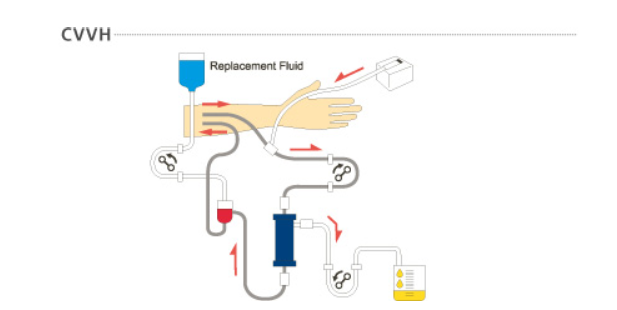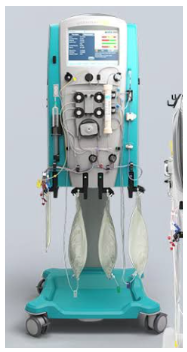By: Thalia Kaylyn Averil
Continuous Veno-Venous Hemofiltration (CVVH) is performed for the short-term treatment of kidney failure. In general, patients who experience kidney failure will undergo hemodialysis, but CVVH may be needed as a backup if the patient has contraindications to hemodialysis. Patients with unstable acute renal failure can also be treated temporarily with CVVH. CVVH is usually used until the patient’s kidney function returns to normal or until hemodialysis can be started.
What are the differences between hemodialysis and Continuous Veno-Venous Hemofiltration (CVVH)?
| Hemodialysis | CVVH |
| Hemodialysis is usually carried out for several hours, with a frequency of approximately three times a week. | CVVH is a continuous therapy conducted for 24 hours. |
| Hemodialysis is less effective at removing excess fluid and dissolved substances from the body. | CVVH is more effective at removing excess fluid and solutes from the body than hemodialysis. |
| Hemodialysis cannot be performed on patients with unstable hemodynamic conditions because it can cause hemodynamic instability. | CVVH causes fewer hemodynamic changes and is thus better tolerated by hemodynamically unstable patients. |
The catheter used during the CVVH procedure has two different routes. The dialysis catheter will be inserted into one of the body’s main veins, such as the femoral vein, jugular vein, or subclavian vein, because CVVH requires adequate vascular access. Blood enters the CVVH machine after the blood exits the catheter through pumping. Inside the machine, blood passes through a semipermeable membrane so that water and dissolved substances, such as waste products, can be removed. However, blood cells and larger molecules are retained. Next, fluids and electrolytes will be replaced with replacement fluid in the form of dialysate solution, thus regulating fluid balance and correcting electrolyte imbalances. In the end, the patient’s filtered blood will be returned to the body using a catheter. During the CVVH procedure, anticoagulants are needed to prevent blood clots. The duration of CVVH varies depending on the patient’s condition and the patient’s response to treatment. The CVVH procedure is usually performed for 24 hours. Other studies show that CVVH is usually performed until hemodialysis can be performed or the patient’s kidney function returns to normal.

Figure 1. Illustration of the working mechanism of Continuous Veno-Venous Hemofiltration (CVVH).
CVVH can be used for patients experiencing acute renal failure, sepsis, septic shock, and multiple organ failure. Apart from that, CVVH can also be used for patients with unstable hemodynamics, including low blood pressure, heartbeat that is too fast or slow, weak or non-palpable pulse, cold skin, reduced urine production, or changes in mental status. However, CVVH is contraindicated in the following patients:
- Patients with limited vascular access.
- Patients who have contraindications to anticoagulant therapy because anticoagulants will be used during the CVVH procedure. Examples include patients with a history of intracranial bleeding, patients who are actively bleeding or have a high risk of bleeding, patients with uncontrolled coagulopathy, patients with severe thrombocytopenia, or patients who have recently undergone gastrointestinal surgery.
The following are the benefits of CVVH for patients with acute kidney failure:
- CVVH can help maintain hemodynamic stability, so it is suitable for patients with contraindications to hemodialysis, such as patients with low blood pressure.
- Large fluid buildup in the body usually occurs in patients with acute renal failure or sepsis. Excess fluid can be removed through ultrafiltration, which is the process of removing water and dissolved molecules from the blood through a semipermeable membrane without removing the solutes. The ultrafiltration rate in CVVH can be controlled and adjusted to the patient’s condition.
- Apart from that, CVVH can also help remove waste substances such as urea, creatinine, and other metabolic products that accumulate in the blood.
- CVVH may require fewer anticoagulants compared to other forms of Continuous Renal Replacement Therapy (CRRT), reducing the risk for patients with bleeding tendencies.
- CVVH can be used as an alternative for patients who have contraindications to hemodialysis due to unstable hemodynamics until hemodialysis can be performed or the patient’s kidney function returns to normal. CVVH is generally performed on patients treated in the intensive care unit (ICU).
Abdi Waluyo Hospital is equipped with Continuous Veno-Venous Hemofiltration (CVVH) which offers services for patients experiencing various conditions, including acute renal failure, sepsis, septic shock, multiple organ failure, and unstable hemodynamic conditions.

Figure 2. Continuous Veno-Venous Hemofiltration (CVVH) machine at Abdi Waluyo Hospital.
Resources
- Massachusetts General Hospital. Continuous Veno-Venous Hemofiltration (CVVH) program [Internet]. Boston: Massachusetts General Hospital; date of publication unknown [cited 2024 Jan 16]. Available from: https://www.massgeneral.org/medicine/nephrology/treatments-and-services/cvvh
- Tandukar S, Palevsky PM. Continuous Renal Replacement Therapy: Who, When, Why, and How. Chest [Internet]. 2019 Mar [cited 2024 Jan 16];155(3):626-638. Available from: https://www.ncbi.nlm.nih.gov/pmc/articles/PMC6435902/
- Saunders H, Rehan A, Sanghavi DK. Continuous Renal Replacement Therapy. [Updated 2023 May 8]. In: StatPearls [Internet]. Treasure Island (FL): StatPearls Publishing; 2023 Jan-. Available from: https://www.ncbi.nlm.nih.gov/books/NBK556028/
- Ronco C, Bellomo R, Kellum JA. Critical care nephrology. 2nd ed. San Francisco: Elsevier: 2008.
- Asahi Kasei Medical. Continuous Renal Replacement Therapy (CRRT) [Internet]. Tokyo: Asahi Kasei; date of publication unknown [cited 2023 Jan 16]. Available from: https://www.asahi-kasei.co.jp/medical/en/apheresis/product/crrt/about/cure.html
